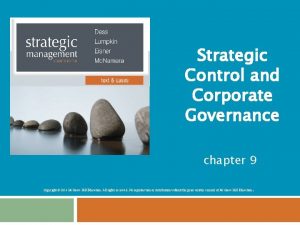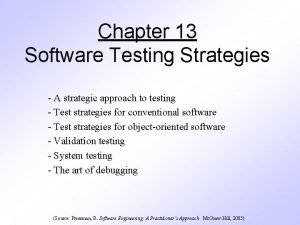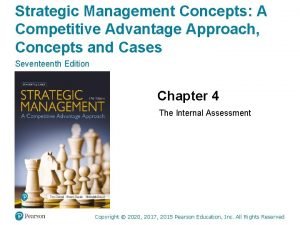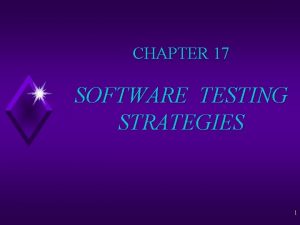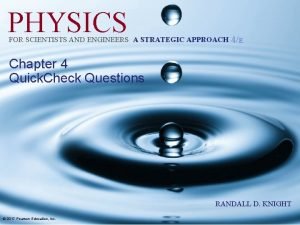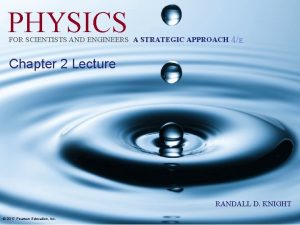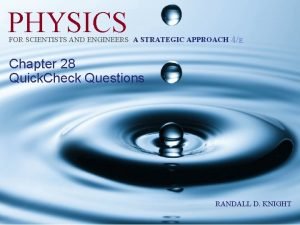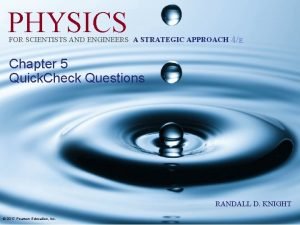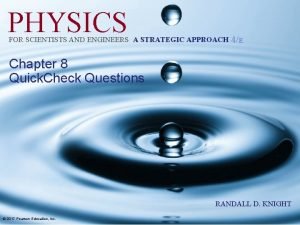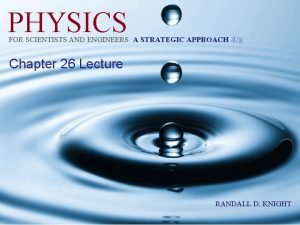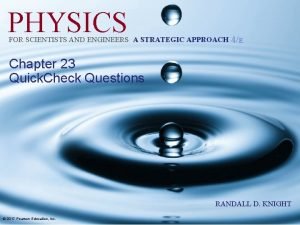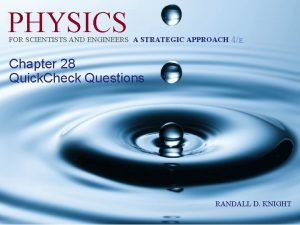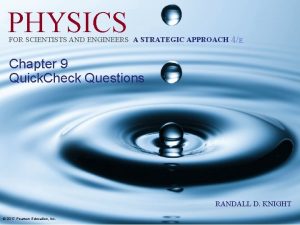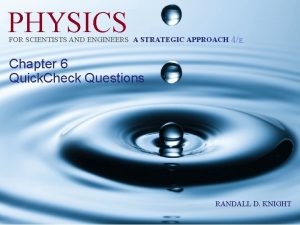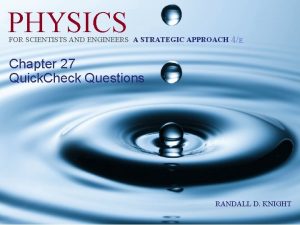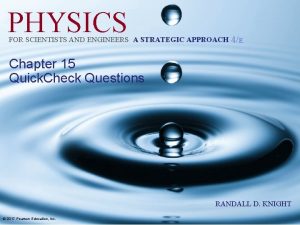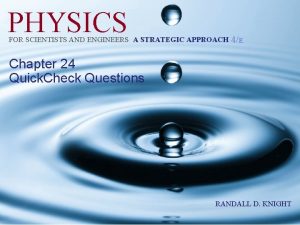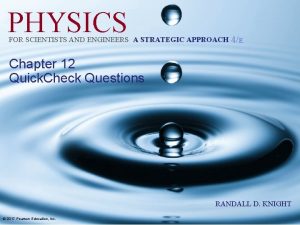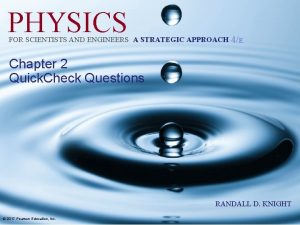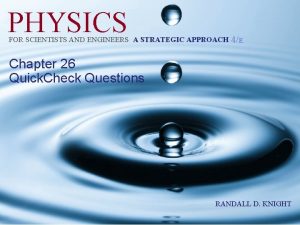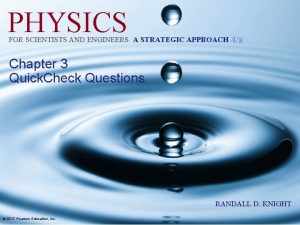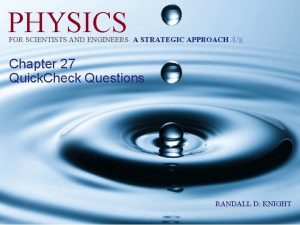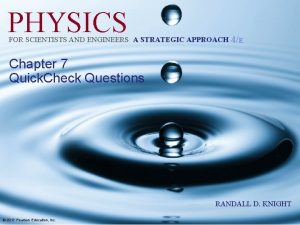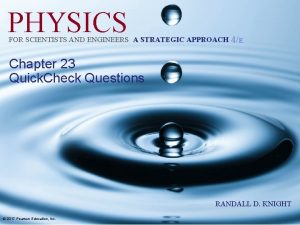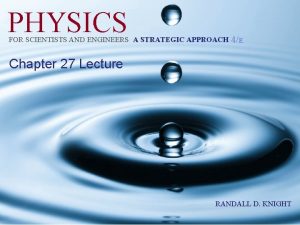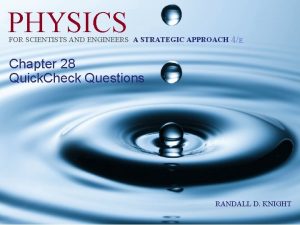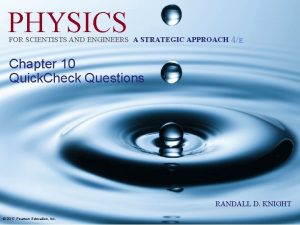PHYSICS FOR SCIENTISTS AND ENGINEERS A STRATEGIC APPROACH

























- Slides: 25

PHYSICS FOR SCIENTISTS AND ENGINEERS A STRATEGIC APPROACH 4/E Chapter 25 Quick. Check Questions RANDALL D. KNIGHT

Quick. Check 25. 1 Two rocks have equal mass. Which has more gravitational potential energy? A. Rock A B. Rock B C. They have the same potential energy. D. Both have zero potential energy. © 2017 Pearson Education, Inc. Slide 25 -2

Quick. Check 25. 1 Two rocks have equal mass. Which has more gravitational potential energy? Increasing PE A. Rock A B. Rock B C. They have the same potential energy. D. Both have zero potential energy. © 2017 Pearson Education, Inc. Slide 25 -3

Quick. Check 25. 2 Two positive charges are equal. Which has more electric potential energy? A. Charge A B. Charge B C. They have the same potential energy. D. Both have zero potential energy. © 2017 Pearson Education, Inc. Slide 25 -4

Quick. Check 25. 2 Two positive charges are equal. Which has more electric potential energy? A. Charge A B. Charge B Increasing PE C. They have the same potential energy. D. Both have zero potential energy. © 2017 Pearson Education, Inc. Slide 25 -5

Quick. Check 25. 3 Two negative charges are equal. Which has more electric potential energy? A. Charge A B. Charge B C. They have the same potential energy. D. Both have zero potential energy. © 2017 Pearson Education, Inc. Slide 25 -6

Quick. Check 25. 3 Two negative charges are equal. Which has more electric potential energy? Increasing PE for negative charge A. Charge A B. Charge B C. They have the same potential energy. D. Both have zero potential energy. © 2017 Pearson Education, Inc. Slide 25 -7

Quick. Check 25. 4 A positive charge moves as shown. Its kinetic energy A. Increases. B. Remains constant. C. Decreases. © 2017 Pearson Education, Inc. Slide 25 -8

Quick. Check 25. 4 A positive charge moves as shown. Its kinetic energy A. Increases. Increasing PE Decreasing KE B. Remains constant. C. Decreases. © 2017 Pearson Education, Inc. Slide 25 -9

Quick. Check 25. 5 A positive and a negative charge are released from rest in vacuum. They move toward each other. As they do, A. A positive potential energy becomes more positive. B. A positive potential energy becomes less positive. C. A negative potential energy becomes more negative. D. A negative potential energy becomes less negative. E. A positive potential energy becomes a negative potential energy. © 2017 Pearson Education, Inc. Slide 25 -10

Quick. Check 25. 5 A positive and a negative charge are released from rest in vacuum. They move toward each other. As they do, A. A positive potential energy becomes more positive. B. A positive potential energy becomes less positive. C. A negative potential energy becomes more negative. D. A negative potential energy becomes less negative. E. A positive potential energy becomes a negative potential energy. © 2017 Pearson Education, Inc. Slide 25 -11

Quick. Check 25. 6 A proton is released from rest at the dot. Afterward, the proton A. Remains at the dot. B. Moves upward with steady speed. C. Moves upward with an increasing speed. D. Moves downward with a steady speed. E. Moves downward with an increasing speed. © 2017 Pearson Education, Inc. Slide 25 -12

Quick. Check 25. 6 A proton is released from rest at the dot. Afterward, the proton A. Remains at the dot. B. Moves upward with steady speed. Decreasing PE Increasing KE C. Moves upward with an increasing speed. D. Moves downward with a steady speed. E. Moves downward with an increasing speed. © 2017 Pearson Education, Inc. Slide 25 -13

Quick. Check 25. 7 If a positive charge is released from rest, it moves in the direction of A. A stronger electric field. B. A weaker electric field. C. Higher electric potential. D. Lower electric potential. E. Both B and D. © 2017 Pearson Education, Inc. Slide 25 -14

Quick. Check 25. 7 If a positive charge is released from rest, it moves in the direction of A. A stronger electric field. B. A weaker electric field. C. Higher electric potential. D. Lower electric potential. E. Both B and D. © 2017 Pearson Education, Inc. Slide 25 -15

Quick. Check 25. 8 Two protons, one after the other, are launched from point 1 with the same speed. They follow the two trajectories shown. The protons’ speeds at points 2 and 3 are related by A. B. C. D. v 2 > v 3 v 2 = v 3 v 2 < v 3 Not enough information to compare their speeds. © 2017 Pearson Education, Inc. Slide 25 -16

Quick. Check 25. 8 Two protons, one after the other, are launched from point 1 with the same speed. They follow the two trajectories shown. The protons’ speeds at points 2 and 3 are related by A. B. C. D. v 2 > v 3 v 2 = v 3 Energy conservation v 2 < v 3 Not enough information to compare their speeds. © 2017 Pearson Education, Inc. Slide 25 -17

Quick. Check 25. 9 What is the ratio VB/VA of the electric potentials at the two points? A. B. C. D. E. 9 3 1/9 Undefined without knowing the charge © 2017 Pearson Education, Inc. Slide 25 -18

Quick. Check 25. 9 What is the ratio VB/VA of the electric potentials at the two points? A. B. C. D. E. 9 3 Potential of a point charge decreases 1/3 inversely with distance. 1/9 Undefined without knowing the charge © 2017 Pearson Education, Inc. Slide 25 -19

Quick. Check 25. 10 An electron follows the trajectory shown from i to f. At point f, A. vf > vi B. vf = vi C. vf < vi D. Not enough information to compare the speeds at these points. © 2017 Pearson Education, Inc. Slide 25 -20

Quick. Check 25. 10 An electron follows the trajectory shown from i to f. At point f, A. vf > vi B. vf = vi C. vf < vi D. Not enough information to compare the speeds at these points. Increasing PE (becoming less negative) so decreasing KE © 2017 Pearson Education, Inc. Slide 25 -21

Quick. Check 25. 11 At the midpoint between these two equal but opposite charges, A. E = 0; V = 0 B. E = 0; V > 0 C. E = 0; V < 0 D. E points right; V = 0 E. E points left; V = 0 © 2017 Pearson Education, Inc. Slide 25 -22

Quick. Check 25. 11 At the midpoint between these two equal but opposite charges, A. E = 0; V = 0 B. E = 0; V > 0 C. E = 0; V < 0 D. E points right; V = 0 E. E points left; V = 0 © 2017 Pearson Education, Inc. Slide 25 -23

Quick. Check 25. 12 At which point or points is the electric potential zero? A. B. C. D. E. More than one of these. © 2017 Pearson Education, Inc. Slide 25 -24

Quick. Check 25. 12 At which point or points is the electric potential zero? V=0 A. B. C. V=0 D. E. More than one of these. © 2017 Pearson Education, Inc. Slide 25 -25
 Strategic complements
Strategic complements Resource based model
Resource based model Analysing the 6 strategic options megxit
Analysing the 6 strategic options megxit Difference between datagram and virtual circuit approach
Difference between datagram and virtual circuit approach Deep learning approach and surface learning approach
Deep learning approach and surface learning approach Strategic fit vs strategic intent
Strategic fit vs strategic intent Incremental approach in strategic management
Incremental approach in strategic management Strategic control and corporate governance
Strategic control and corporate governance Strategic choice approach
Strategic choice approach A strategic approach to software testing
A strategic approach to software testing Strategic management a competitive advantage approach
Strategic management a competitive advantage approach A strategic approach to software testing
A strategic approach to software testing Commander approach in strategic management
Commander approach in strategic management After the experiment scientists organize and the data
After the experiment scientists organize and the data Diagrams tables and graphs are used by scientists mainly to
Diagrams tables and graphs are used by scientists mainly to Why does it happen
Why does it happen University physics with modern physics fifteenth edition
University physics with modern physics fifteenth edition Example physics ia
Example physics ia Iso 22301 utbildning
Iso 22301 utbildning Typiska novell drag
Typiska novell drag Tack för att ni lyssnade bild
Tack för att ni lyssnade bild Returpilarna
Returpilarna Varför kallas perioden 1918-1939 för mellankrigstiden?
Varför kallas perioden 1918-1939 för mellankrigstiden? En lathund för arbete med kontinuitetshantering
En lathund för arbete med kontinuitetshantering Särskild löneskatt för pensionskostnader
Särskild löneskatt för pensionskostnader Vilotidsbok
Vilotidsbok







